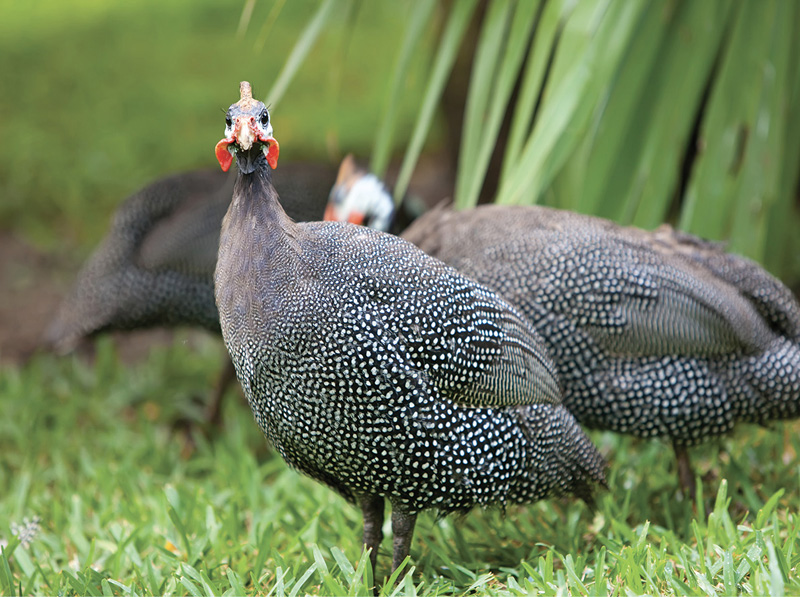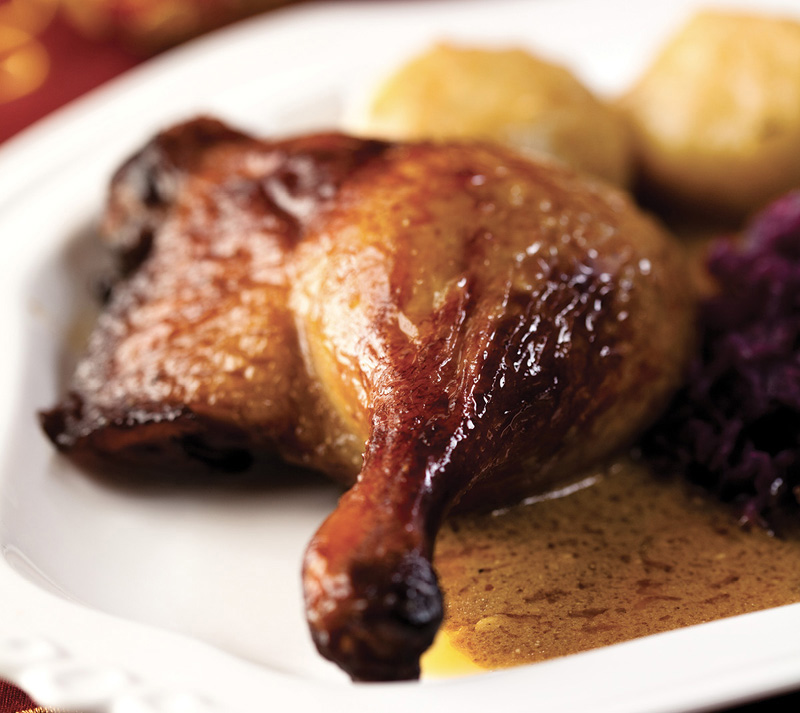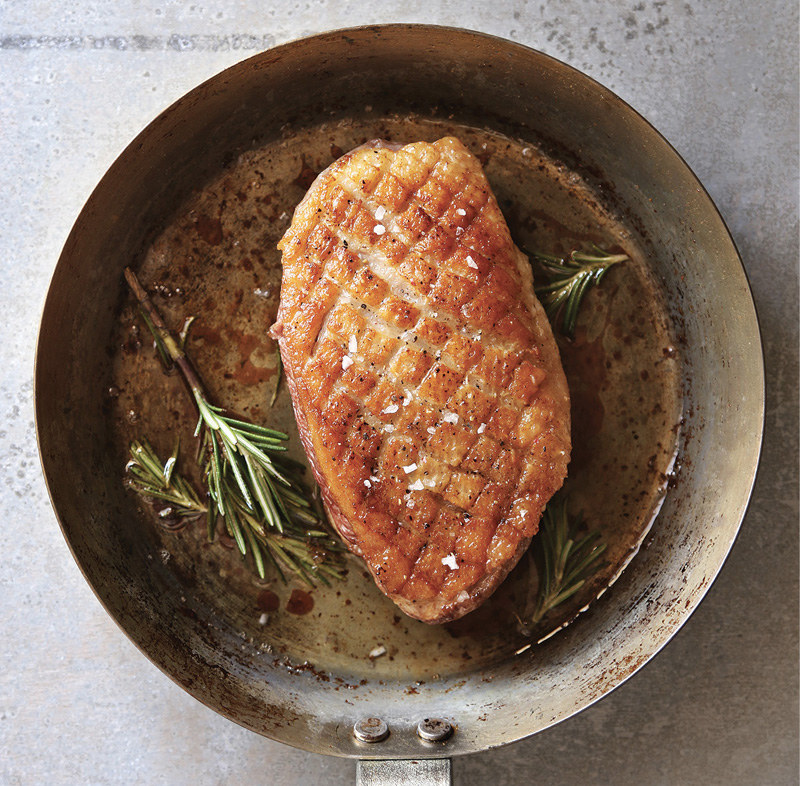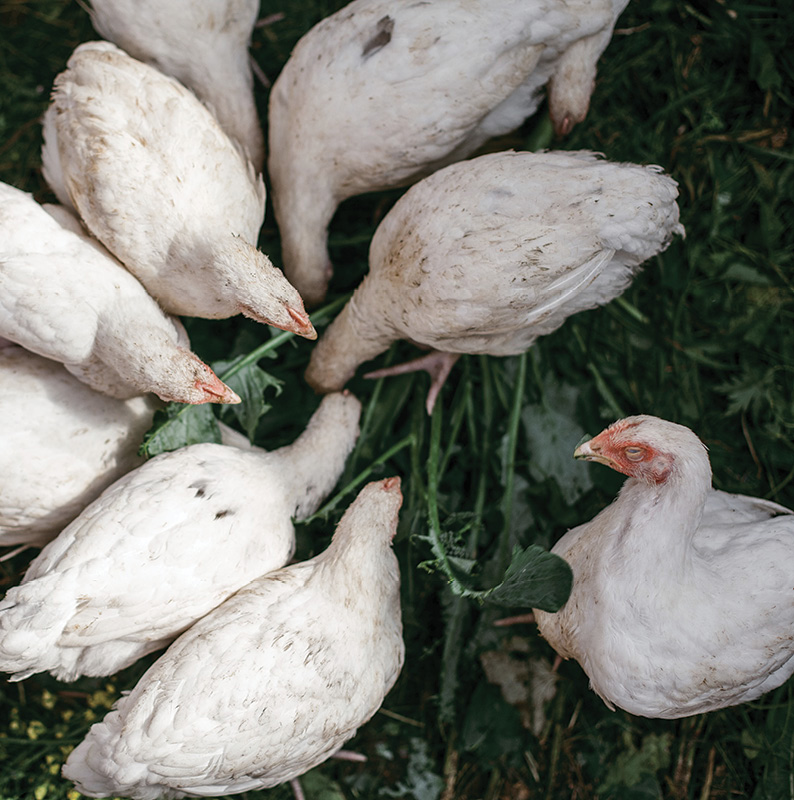Chapter 6
POULTRY
(Volaille)

Recipes featured in this chapter:
Pan-Roasted Duck Breast (Magret de Canard) with Seared Mirabelle Plums
Chicken (Poulet) with Tomatoes and Olives
Guinea Fowl (Pintade) à la Normande
Rabbit (Lapin) with Prunes (Pruneaux)
Pearl Couscous
People who have a chance to live, even for a little while, in La Belle France get to experience her culinary blessings, such as living cheese that hasn’t been killed with pasteurizing heat, chicken that tastes like the real thing, and some of the most heavenly wines in the world. One of her unique gifts is the availability of what I firmly believe is God’s poultry gift to man: duck. Duck is to the French as chicken is to Americans. We’ll get to the part about eating the duck itself later in this chapter, but first I want to extol the virtues of its stunning by-product, duck fat. If you have not cooked with this indispensable ingredient, you’re in for an astounding revelation. Its smoking point is higher than butter, and it’s fabulous for frying and flavoring potatoes, mushrooms, greens, popcorn, and almost anything else. It also has less saturated fats than butter or bacon! In any French market, you’ll see many kinds of duck fat crowding the butter case, but in the United States, it’s not so readily available. I’ve resorted to ordering jars of it online. It keeps in the refrigerator for ages, although it doesn’t last long enough at our house for me to tell you exactly how long. It’s expensive, but because its flavor is so distinct and it’s good for you relative to similar fats, it’s worth the splurge. You can find it on Amazon and many specialty grocery websites. Now that I’ve done my bit to make your cooking experience better with this divine, silky, yellow miracle, we’ll talk about the bird itself.
Duck (Canard)
One warm summer day, as Tim and I strolled along Rue Vaugirard near our first apartment in Paris, he stopped abruptly, annoying the small French lady who was bustling along close to his heels. When I looked at him in alarm he pointed to the little store next to us. It was a shop devoted entirely to duck!
There were towers of tinned duck, jarred duck, duck pâté, cassoulet, and many other goodies that I couldn’t identify. There were frozen ducks and duck parts in the freezer case, fresh duck, and even preprepared duck confit in the cool cases. There were books about duck, posters of ducks lolling around ponds and swimming in rivers, and anatomical drawings of duck parts.
“Only in France,” I thought.
A little bell on the door tinkled as we entered, and through a bright yellow curtain at the back of the store came Madame Allard, who was destined to become a great pal and instructor about all things duck-related.
After our bonjours she switched to English. She was amused at our enthusiasm and our surprise at finding a store dedicated solely to our favorite fowl, and we spent half an hour admiring her stock while that little bell rang with other customers’ arrivals. Of course, our little plaid cart was brimming with pâté, duck breast, duck fat, and a cute little recipe book in English.
That very night I made my first attempt at cooking a duck breast. I had phoned Deborah first to confirm what the little book had told me. I was very proud of myself when Tim congratulated me on a great meal, and I was able to add another dish to my repertoire.
If I can do it, so can you! If you’re ever going to cook duck, now is the time to try it. When you go to the market, or better yet the boucherie in France, you’ll find it easily.

Chicken (Poulet)
When we travel to France, and many other countries for that matter, I am always surprised the first time I order chicken in a restaurant or cook it in our rental kitchen. The raw chickens in the markets almost always have a yellow tinge to their skin, which can be a little alarming until you realize that those free-range birds have been pecking away at marigold seeds or sometimes corn. Since they aren’t pumped up with water and hormones, they’re smaller than what we typically get in the United States. And here’s the very best part: These birds taste like chicken! Those of us of a certain age can remember what chicken tasted like years ago, back when we were children. So if you’re one of us, you’re in for a little tastebud déjà vu in France when you eat chicken.
To further your trip back in time, there might even be a couple of pinfeathers left on the bird. Just make sure to remove them before cooking. In Ireland, where I lived for a few years in the early ’90s, the chickens came with more than a few pinfeathers, too many to pluck by hand. My neighbor taught me to zap the fowl over an open flame to make the feathers disappear. It smelled awful but certainly did the job. The French are more fastidious about feathers, so searing the bird won’t be necessary.
A proper French butcher would never dream of expecting you to deal with pinfeathers, globs of fat, sinew, or anything you wouldn’t want to eat. It will cost you a few more bucks to shop with the butcher than at a grocery story, but it will be infinitely more fun and you’ll get better-quality poultry in the bargain.
Guinea Fowl (Pintade)
Guinea fowl or guinea hens are uncommon in the United States, where they are quite expensive and not easy to find. The French consume them with gusto, because these relatives of chickens, pheasants, and partridges have roughly half the fat of chicken and marginally more protein than turkey. Their meat is dark and reminiscent of pheasant, but less gamey. Their eggs are substantially richer than chicken eggs.
Rabbit (Lapin)
You may wonder about finding a rabbit recipe tucked into the poultry section of this book, but the fact is that rabbit is a common and delicious source of protein and is served in many cultures. France, Italy, and Spain produce and consume more rabbit than any other countries in Europe. In Italy, it’s usually doused in some flavorful concoction and braised to ensure a tender and moist result; the French by contrast favor mustard as their classic flavor. Rabbit is enjoying a wave of popularity in the United States, where the public is learning to separate what’s on their plate from their memory of Brer Rabbit or that sweet little bunny their third-grade class raised. Let’s face it, many of us eat cute little lambs, fluffy chicks, and relatives of Bambi without a thought, so why not rabbit? Rabbit meat is all-white meat, low in fat, high in protein, and relatively low in cholesterol and sodium. What’s more, it’s highly palatable and easily digested. Rabbit has a higher percentage of protein and a lower percentage of fat than chicken, turkey, beef, or pork. Not only is it a source rich in unsaturated omega fatty acids, but it is also a lean source of protein that can be substituted for red meat and poultry in most recipes. So set aside your squeamishness, get out that ovenproof pot, and start a new cooking adventure!
 DUCK (Canard)
DUCK (Canard)
IF YOU HAVE BEEN reluctant to attempt cooking duck, this recipe will change your mind. Just follow Deborah’s recipe and you will feel like a duck expert.

Pan-Roasted Duck Breast (Magret de Canard) with Seared Mirabelle Plums
 serves 4
serves 4 
Deborah’s cousin grows stone fruit in California’s Central Valley. They have so much of it that she was inspired to devise ways to put it on her restaurant’s menu. This recipe, which was a big hit with customers, was inspired by her friend Chris Wright, owner of the intimate Parisian restaurant Le Timbre on Rue Sainte-Beuve in the 6th arrondissement. The two chefs, who met sitting at a bar in the Pigalle neighborhood of Paris, opened their restaurants within months of each other and have remained great friends. Chris is masterful at combining fresh, simple tastes, as you’ll see when you try this easy, flavorful duck breast.
Ingredients
4 duck breasts, skin on
Salt
Pepper
Other spices (alone or a mixture), such as coriander, ground fennel, ground ginger, tiny bit of ground clove (optional)
5 mirabelle plums, or other plums, firm but ripe, quartered (or peaches)
2 tablespoons (30 ml) brandy
2 tablespoons (30 ml) honey
Juice from ½ orange
¼ teaspoon (.5 g) orange zest
1 teaspoon (5 g) chopped fresh thyme
Equipment
Knife for slicing and chopping
Large sauté pan
Measuring spoons
Method
1. Trim excess fat off the breasts and score the skin by quickly drawing your sharpened knife across the skin diagonally six or seven times, then do it again in the opposite direction so that a diamond pattern is created.
2. Season with salt and pepper plus other spices, if you wish.
3. In a cold sauté pan, sprinkle about ¼ teaspoon (1.5 g) of salt, and place breasts skin side down, leaving room between each breast. Turn the heat on low and let cook until the skin becomes golden brown. Keep the temperature low. This will render the fat and create a crispy skin. Depending on the thickness of the breast, this could take between 10 and 15 minutes. The breast should be almost finished.
4. Turn the breast over and finish cooking for about 5 more minutes. Be careful not to overcook.
5. Pull the breasts out of the pan and let them rest no more than 10 minutes.
6. Immediately, while the duck is resting, pour all but about 1 tablespoon of the duck fat out of the pan (and reserve it for another use!). Turn up the heat to the highest setting. When it’s hot, toss in the plum quarters and sear quickly, turning them over after about 30 seconds. You don’t want them to get mushy.
7. Deglaze with the brandy. Add the honey, orange juice, and orange zest. Season with salt and pepper.
8. Cut each breast, diagonally, into 3 pieces. Put either on dinner plates or on a platter if you are serving family style. Put the plums on the plates or the platter. Drizzle the sauce over the duck and sprinkle with thyme.
Pairing Red Bordeaux or Pinot Noir
 CHICKEN (Poulet)
CHICKEN (Poulet)
LIKE ALMOST EVERYTHING ELSE, the French have a way with chicken—or should I say many ways?

Chicken (Poulet) with Tomatoes and Olives
 serves 4
serves 4 
This dish, which can be easily re-created almost anywhere on earth, is satisfying soul food. Just the ticket when you’re tired and want a simple meal in a hurry.
Ingredients
21 garlic cloves
4 tablespoons (60 ml) olive oil, divided, plus more for drizzling
1½ teaspoons (12 g) piment d’espelette or red pepper flakes (if not available, use half black pepper and half paprika)
2 teaspoons (10 ml) soy sauce or tamari
1 large chicken, pinfeathers removed, quartered
Sea salt
2 pounds (900 g) fresh tomatoes, whatever kind you like; halved or quartered if large, or you can use whole grape tomatoes
2 small heads escarole, cut into 6 wedges each
½ cup (125 ml) Castelvetrano or picholine olives, pitted (or olive of your choice)
2 tablespoons (30 ml) olive juice
3 sprigs thyme, finely chopped, plus more for garnish
1 crusty baguette, sliced in half lengthwise
Equipment
Knife for chopping and slicing
Measuring cups and spoons
Large baking dish
Large spoon
Method
1. Preheat oven to 450°F (235°C). Finely chop one garlic clove and mix it with 1 tablespoon (15 ml) of the olive oil, pepper, and soy sauce. Rub this all over the chicken pieces, then season with salt.
2. In a large baking dish, toss tomatoes, escarole, the remaining garlic cloves, olives, olive juice, and thyme with the remaining 3 tablespoons (45 ml) of olive oil. Season with salt and black pepper.
3. Arrange chicken on top of the tomato mixture.
4. Roast until brown and cooked through, 45 to 50 minutes.
5. Remove chicken from the pan to rest.
6. Put the vegetables back in the oven.
7. Drizzle olive oil on open side of the baguette halves, season with salt, and stick on the top shelf in the oven for about five minutes or until nicely toasted. Cut each piece of baguette in half to make four servings.
8. Put the lightly toasted baguette pieces in 4 large soup/pasta bowls or on dinner plates.
9. Place a quarter chicken in each bowl on the bread, and spoon the vegetables around the chicken. Spoon over the pan juices and sprinkle with more fresh thyme.
Pairing Red Bordeaux
Variations, Ideas, Suggestions
• You could substitute summer squash for the escarole if that suits your taste.
• For a vegetarian version, substitute small halved potatoes, roasting onions, or summer squash for the chicken. Add some white wine to the roasting liquid. Top the toasted bread with the vegetable mixture, then some mozzarella, and put back in the oven to slightly melt the cheese. Top with fresh thyme.
Tip: To peel garlic cloves more easily, start by rolling them gently under the flat side of a large knife blade first.
 GUINEA FOWL (Pintade)
GUINEA FOWL (Pintade)
I REMEMBER hearing the phrase “Guinea hen under glass” when I was a child. It meant that something elegant, exotic, and expensive was about to be presented at the table. In France, it’s an everyday menu item—certainly not served under a glass dome!
Guinea Fowl (Pintade) à la Normande
 serves 4
serves 4 
If you’re in France, you really should take the opportunity to try this luscious recipe.
Ingredients
4 airline guinea fowl breast halves, skin on (a full airline is chef-speak for the partial wing bone still attached to the breast for added flavor and presentation)
Salt
Pepper
4 tablespoons (60 ml) butter or olive oil
4 apples, cut into 1 to 2-inch (25–50 mm) pieces
2 turnips, cut into 1 to 2-inch (25–50mm) pieces
¼ cup (60 ml) brandy
¼ cup (60 ml) cream
½ cup (120 ml) chicken stock or broth
½ cup (120 ml) apple juice
2 tablespoons (30 g) chopped thyme
Equipment
Knife for chopping and slicing
Large ovenproof pan
Measuring cups and spoons
Tongs or a fork for turning meat
Method
1. Preheat oven to 350°F (180°C).
2. Season the guinea fowl with salt and pepper.
3. Heat butter in an ovenproof pan on medium-high heat. Add the fowl and brown evenly on all sides.
4. Add apple and turnips and sauté until golden brown. If there is no room in the pan for the apple and turnip, then remove the fowl first. When the apple and turnips are golden, add the fowl back and deglaze with brandy.
5. Add cream, stock, and apple juice, cover the pan and put in oven for about 30 minutes. If you don’t have an oven, just lower the flame and cook for about 30 minutes, covered. Check the turnips and breasts for doneness. Adjust seasonings.
6. Slice the guinea fowl breasts and serve with sauce spooned over the top and apples and turnips on the side. Sprinkle thyme over the fowl.
Pairing Grenache, Pinot Noir, Rhône white, Côte de Beaune
 RABBIT (Lapin)
RABBIT (Lapin)
DEBORAH HAS DEVELOPED a different take on the traditional French rabbit dish. She’s added some capers, which makes it somewhat reminiscent of the Silver Palate Cookbook classic Chicken Marbella dish. If you can’t bring yourself to experiment with rabbit, this recipe is just as mouthwatering if you substitute chicken.
Rabbit (Lapin) with Prunes (Pruneaux)
 serves 4
serves 4 
Use one rabbit, cut into pieces, as you would a chicken—about 2 ½ pounds (1.25 kg). If the rabbit is very small, you may need two. Weigh the pieces, not the whole rabbit. (We recommend having the butcher cut the rabbit.)
Ingredients
16 prunes, pitted
¼ cup (60 ml) brandy
Approximately 2½ pounds (1.25 kg) rabbit pieces
Salt
Pepper
Flour for dusting (optional)
3 tablespoons (45 ml) vegetable oil
6 cloves garlic, finely minced
¼ cup (60 ml) plus 3 tablespoons (45 ml) olive oil
1½ cups (350 ml) white wine (you can substitute red wine if that’s what you have on hand)
1 cup (250 ml) chicken stock
¼ cup (60 ml) red wine vinegar or another similar vinegar
2 tablespoons (30 ml) Dijon mustard (smooth)
2 tablespoons (30 g) capers
2 tablespoons (30 ml) caper liquid from the jar of capers
¼ cup (50 g) brown sugar
3 sprigs fresh thyme
Chopped parsley
Pearl Couscous (page 135), for serving
Equipment
Bowl
Measuring cups and spoons
Medium ovenproof pot with cover
Method
1. Preheat the oven to 300°F (150°C).
2. Place the prunes in a bowl and pour the brandy over. Set aside and let soak.
3. Season the rabbit pieces with salt and pepper. Then dust with flour, if using.
4. Heat the vegetable oil in ovenproof pot on medium-high heat and lightly brown the rabbit pieces in batches. Remove rabbit and set aside.
5. Lower the heat and let the pan cool down a bit, then add the garlic and 3 tablespoons of olive oil, and simmer until fragrant, about 2 minutes—do not brown the garlic or it will be bitter. Deglaze with the wine, scraping the sides of the pan to release the fond (tasty bits).
6. Add the rabbit, chicken stock, vinegar, mustard, ¼ cup olive oil, capers, caper liquid, brown sugar, thyme, and prunes with brandy.
7. Cover and bake in the oven for about 1 hour, stirring occasionally.
8. Remove the lid and cook for another half hour, until the rabbit (or chicken) is very tender. Remove the thyme sprigs.
9. Serve in bowls or plates on top of Pearl Couscous (see page 135), with plenty of the braising liquid spooned over.
10. Sprinkle with chopped parsley, or you can serve with the Roasted Carrots in the Entertaining chapter (see page 47) and top with minced carrot tops.
Pairing Côtes de Bourg, Alsacian Pinot Gris, mead
Variations, Ideas, Suggestions
• If the sauce is not thick enough for you, after removing the rabbit and the prunes, reduce a bit more and then spoon it over the rabbit.
• If you don’t have an oven, or it’s unreliable, you can simmer on the stove, covered, for about 1½ hours until tender.
• Try leaving the brown sugar out of the braising liquid, sprinkle it on the rabbit, and bake uncovered at 350°F (180°C) for about 50 minutes or until the meat is separating from the bone. This will naturally reduce the liquid and crisp up the rabbit a bit.
• Also great with polenta or potato purée, if you’re so inclined to make it. Or try it with a delicious white bean ragout.
• You could leave the capers out of the dish and fry them in a pan with about a half inch of oil until crispy, and then sprinkle them over the plated dish. But don’t omit the caper liquid.
Pearl Couscous
 serves 4
serves 4 
Pearl couscous, also called Israeli couscous, is larger in size than traditional couscous. Try lightly toasting the couscous until barely golden on a sheet pan in a 350°F (180°C) oven. This will add an interesting toasty flavor. You can also toast the couscous in a large sauté pan on medium heat. Make sure to keep shaking the pan so the pearls toast evenly.
Ingredients
⅔ cups (150 ml) chicken broth
⅔ cup (150 ml) water
1 cup (150 g) pearl couscous
¼ teaspoon (1.5 g) cinnamon
¼ teaspoon (1.5 g) sea salt
Equipment
Medium saucepan with a snug-fitting lid
Measuring cups and spoons
Method
1. Add the stock and water to a medium saucepan and bring to a boil.
2. Add the couscous, cinnamon, and salt. Reduce the heat and simmer, tightly covered, until water is absorbed, about 10 minutes.
3. Remove from the heat and let stand, still covered, for about 3 more minutes.
4. Remove the lid and fluff a bit with a fork. Serve.
Variations, Ideas, Suggestions
• Cook with vegetable stock or salted water if you would like to serve the couscous with something vegetarian.
• Toss with Roasted Cauliflower (Chou-Fleur) with Currants and Capers (see page 209) and some sautéed kale for a lovely warm salad for lunch or dinner.




